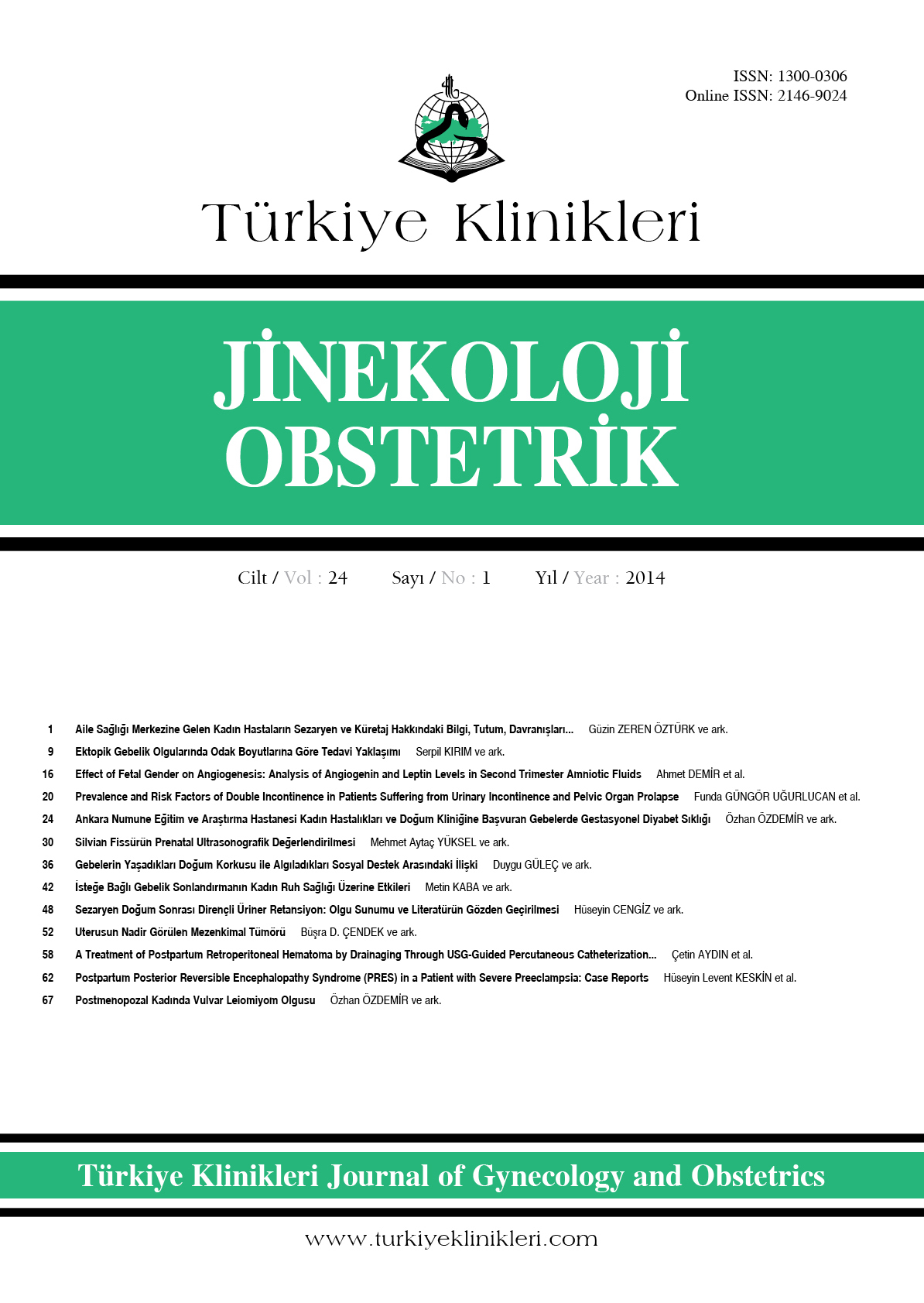Open Access
Peer Reviewed
CASE REPORTS
2991 Viewed1455 Downloaded
Postpartum Posterior Reversible Encephalopathy Syndrome (PRES) in a Patient with Severe Preeclampsia: Case Report
Şiddetli Preeklampsi Olgusunda Postpartum Posterior Reversibl Ensefalopati Sendromu (PRES)
Turkiye Klinikleri J Gynecol Obst. 2014;24(1):62-6
Article Language: EN
Copyright Ⓒ 2025 by Türkiye Klinikleri. This is an open access article under the CC BY-NC-ND license (http://creativecommons.org/licenses/by-nc-nd/4.0/)
ABSTRACT
Posterior reversible encephalopathy syndrome (PRES) is typically characterized by the vasogenic edema in the occipitopariatel area of the brain in clinical and radiological findings. Various factors accounts for the etiology and the symptoms include sudden loss of vision, seizures, headache, and mental status alterations. In this report, we present a 27-year-old primigravida at 34 weeks 6 days of pregnancy who admitted to our hospital with high blood pressure (BP) and headache. The patient was diagnosed preeclampsia with respect to clinical findings and laboratory results, and the baby was delivered by cesarean section because of severe preeclampsia and fetal distress at the 3rd hour of admission to the hospital. In the postoperative period, high BP did not respond to multiple antihypertensive treatment and headache continued. On the 4th day of the follow-up sudden loss of vision developed in the patient, however fundoscopic examination was normal. In the cranial magnetic resonance imaging, some findings interpreting as PRES were detected in bilateral occipital lobes symmetrically, in both of the basal ganglia and left thalamus, and in cortical and subcortical white matter areas. The recovery without any sequelae was occurred with antiedema treatment applying immediately beside antihypertensive therapy. As a result, PRES should be considered in differential diagnosis in preeclamptic cases who has clinical findings supported by radiological methods and the treatment should be immediately administrated.
Posterior reversible encephalopathy syndrome (PRES) is typically characterized by the vasogenic edema in the occipitopariatel area of the brain in clinical and radiological findings. Various factors accounts for the etiology and the symptoms include sudden loss of vision, seizures, headache, and mental status alterations. In this report, we present a 27-year-old primigravida at 34 weeks 6 days of pregnancy who admitted to our hospital with high blood pressure (BP) and headache. The patient was diagnosed preeclampsia with respect to clinical findings and laboratory results, and the baby was delivered by cesarean section because of severe preeclampsia and fetal distress at the 3rd hour of admission to the hospital. In the postoperative period, high BP did not respond to multiple antihypertensive treatment and headache continued. On the 4th day of the follow-up sudden loss of vision developed in the patient, however fundoscopic examination was normal. In the cranial magnetic resonance imaging, some findings interpreting as PRES were detected in bilateral occipital lobes symmetrically, in both of the basal ganglia and left thalamus, and in cortical and subcortical white matter areas. The recovery without any sequelae was occurred with antiedema treatment applying immediately beside antihypertensive therapy. As a result, PRES should be considered in differential diagnosis in preeclamptic cases who has clinical findings supported by radiological methods and the treatment should be immediately administrated.
ÖZET
Posterior Reversibl Ensefalopati Sendromu (PRES) etiyolojisinde çeşitli faktörler rol alan, ani gelişen görme kaybı, epileptik nöbet, baş ağrısı ve mental durum değişikliği ile birlikte görülebilen, tipik olarak beynin oksipitopariatel bölgesinde vazojenik ödem ile karakterize klinik ve radyolojik bulguları olan bir sendromdur. Bu yazıda, 27 yaşında, primigravid, 34 hafta 6 gün'lük gebeliği mevcut iken baş ağrısı ve kendi ölçtüğü kan basıncı (KB) değerinin yüksek olması nedeniyle hastanemize başvuran olgu sunulmuştur. Yapılan muayene ve tetkikler sonucunda hastaya preeklampsi tanısı konulmuş ve başvurusunun 3. saatinde şiddetli preeklampsi ve fetal distress endikasyonları ile sezaryen ile doğum gerçekleştirilmiştir. Hastanın postoperatif takiplerinde KB yüksekliği ve baş ağrısı devam etmiş çoklu antihipertansif tedaviye yanıt vermemiştir. Takibinin 4. gününde ani görme kaybı gelişen ve fundoskopik muayenesi normal olan hastanın Kranial Manyetik Rezonans görüntülemesinde özellikle bilateral oksipital lobda, her iki bazal ganglionda, talamusta, kortikal ve subkortikal beyaz cevher alanlarında PRES lehine yorumlanan bulgular dikkati çekmiştir. Antihipertansif tedavi yanında, hızla hastaya uygulanan antiödem tedavi ile sekelsiz iyileşme sağlanmıştır. Sonuç olarak, preeklamptik bir olguda klinik bulguların varlığı durumunda ayırıcı tanıda mutlaka PRES'ten şüphelenilmesi, radyolojik yöntemlerle tanının desteklenmesi ve tedavinin hızla uygulanması gerekir.
Posterior Reversibl Ensefalopati Sendromu (PRES) etiyolojisinde çeşitli faktörler rol alan, ani gelişen görme kaybı, epileptik nöbet, baş ağrısı ve mental durum değişikliği ile birlikte görülebilen, tipik olarak beynin oksipitopariatel bölgesinde vazojenik ödem ile karakterize klinik ve radyolojik bulguları olan bir sendromdur. Bu yazıda, 27 yaşında, primigravid, 34 hafta 6 gün'lük gebeliği mevcut iken baş ağrısı ve kendi ölçtüğü kan basıncı (KB) değerinin yüksek olması nedeniyle hastanemize başvuran olgu sunulmuştur. Yapılan muayene ve tetkikler sonucunda hastaya preeklampsi tanısı konulmuş ve başvurusunun 3. saatinde şiddetli preeklampsi ve fetal distress endikasyonları ile sezaryen ile doğum gerçekleştirilmiştir. Hastanın postoperatif takiplerinde KB yüksekliği ve baş ağrısı devam etmiş çoklu antihipertansif tedaviye yanıt vermemiştir. Takibinin 4. gününde ani görme kaybı gelişen ve fundoskopik muayenesi normal olan hastanın Kranial Manyetik Rezonans görüntülemesinde özellikle bilateral oksipital lobda, her iki bazal ganglionda, talamusta, kortikal ve subkortikal beyaz cevher alanlarında PRES lehine yorumlanan bulgular dikkati çekmiştir. Antihipertansif tedavi yanında, hızla hastaya uygulanan antiödem tedavi ile sekelsiz iyileşme sağlanmıştır. Sonuç olarak, preeklamptik bir olguda klinik bulguların varlığı durumunda ayırıcı tanıda mutlaka PRES'ten şüphelenilmesi, radyolojik yöntemlerle tanının desteklenmesi ve tedavinin hızla uygulanması gerekir.
MENU
POPULAR ARTICLES
MOST DOWNLOADED ARTICLES





This journal is licensed under a Creative Commons Attribution-NonCommercial-NoDerivatives 4.0 International License.










